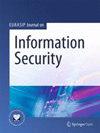基于深度学习和随机投影的安全人脸验证可取消模板
IF 2.5
Q2 COMPUTER SCIENCE, INFORMATION SYSTEMS
引用次数: 0
摘要
最近,生物识别已成为一个重要的研究领域。可取消生物识别(CB)的概念已被引入,以解决与处理敏感数据有关的安全问题。在本文中,我们提出了一种名为 BiometricNet+ 的深度可取消框架,利用随机投影(RP)隐藏人脸图像,并利用压缩传感(CS)重建原始域中的测量值,从而解决无约束人脸验证问题。我们的轻量级设计在保持人脸识别准确性的同时,还强化了模板的不可链接性、可撤销性和不可逆转性。我们通过学习正则化度量来比较面部特征:在训练时,我们共同学习面部特征和度量,从而将匹配和非匹配对映射到潜在目标分布上;然后,在生物识别验证时,通过每次注册和查询时改变的随机矩阵随机投射特征,并在计算潜在空间映射之前进行重建。我们在具有挑战性的数据集(如 LFW、CALFW、CPLFW、AgeDB、YTF、CFP 和 RFW)上评估了我们的框架的人脸识别准确性,结果表明,与最先进的技术相比,我们的框架有显著的改进,同时符合安全可取消模板设计的标准。由于我们的方法不需要对学习到的特征进行微调,因此它可以应用于预训练网络,以加强敏感数据的保护。本文章由计算机程序翻译,如有差异,请以英文原文为准。
Cancelable templates for secure face verification based on deep learning and random projections
Recently, biometric recognition has become a significant field of research. The concept of cancelable biometrics (CB) has been introduced to address security concerns related to the handling of sensitive data. In this paper, we address unconstrained face verification by proposing a deep cancelable framework called BiometricNet+ that employs random projections (RP) to conceal face images and compressive sensing (CS) to reconstruct measurements in the original domain. Our lightweight design enforces the properties of unlinkability, revocability, and non-invertibility of the templates while preserving face recognition accuracy. We compare facial features by learning a regularized metric: at training time, we jointly learn facial features and the metric such that matching and non-matching pairs are mapped onto latent target distributions; then, for biometric verification, features are randomly projected via random matrices changed at every enrollment and query and reconstructed before the latent space mapping is computed. We assess the face recognition accuracy of our framework on challenging datasets such as LFW, CALFW, CPLFW, AgeDB, YTF, CFP, and RFW, showing notable improvements over state-of-the-art techniques while meeting the criteria for secure cancelable template design. Since our method requires no fine-tuning of the learned features, it can be applied to pre-trained networks to increase sensitive data protection.
求助全文
通过发布文献求助,成功后即可免费获取论文全文。
去求助
来源期刊

EURASIP Journal on Information Security
COMPUTER SCIENCE, INFORMATION SYSTEMS-
CiteScore
8.80
自引率
0.00%
发文量
6
审稿时长
13 weeks
期刊介绍:
The overall goal of the EURASIP Journal on Information Security, sponsored by the European Association for Signal Processing (EURASIP), is to bring together researchers and practitioners dealing with the general field of information security, with a particular emphasis on the use of signal processing tools in adversarial environments. As such, it addresses all works whereby security is achieved through a combination of techniques from cryptography, computer security, machine learning and multimedia signal processing. Application domains lie, for example, in secure storage, retrieval and tracking of multimedia data, secure outsourcing of computations, forgery detection of multimedia data, or secure use of biometrics. The journal also welcomes survey papers that give the reader a gentle introduction to one of the topics covered as well as papers that report large-scale experimental evaluations of existing techniques. Pure cryptographic papers are outside the scope of the journal. Topics relevant to the journal include, but are not limited to: • Multimedia security primitives (such digital watermarking, perceptual hashing, multimedia authentictaion) • Steganography and Steganalysis • Fingerprinting and traitor tracing • Joint signal processing and encryption, signal processing in the encrypted domain, applied cryptography • Biometrics (fusion, multimodal biometrics, protocols, security issues) • Digital forensics • Multimedia signal processing approaches tailored towards adversarial environments • Machine learning in adversarial environments • Digital Rights Management • Network security (such as physical layer security, intrusion detection) • Hardware security, Physical Unclonable Functions • Privacy-Enhancing Technologies for multimedia data • Private data analysis, security in outsourced computations, cloud privacy
 求助内容:
求助内容: 应助结果提醒方式:
应助结果提醒方式:


